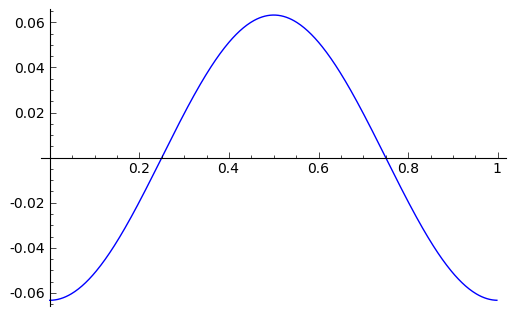Lattice quantum mechanics in 1d
This post has been migrated from my old blog, the math-physics learning seminar.
For some reason I’ve been interested in lattice QFT recently, especially lattice gauge theory (note to self: a miniproject for the Christmas break is to understand the paper by Kogut and Susskind http://prd.aps.org/abstract/PRD/v11/i2/p395_1). As a warm-up, I thought I would try understanding plain-old 1D QM on the lattice, and writing some code to see if I got results that are at all reasonable.
The Setup: We will take as our space of states \(\mathscr{H} = L^2([0,1])\) and hamiltonian
\[ H = -\frac{d^2}{dx^2} + V(x). \]
for some real function \(V(x)\) defined on \([0,1]\).
Now fix some large positive integer \(N\). Let \(\epsilon = 1/N\). We will consider the subspace \(\mathscr{H}_N\) of \(\mathscr{H}\) spanned by those functions that are constant on the subintervals \(i\epsilon, (i+1)\epsilon)\). Such a function is defined (a.e.) by the \(N\) values it takes on these intervals, so we may identify \(\mathscr{H}_N \cong \mathbb{C}^N\) as vector spaces. Let us denote elements of \(\mathscr{H}_N\) by \(\psi_i\) for \(i = 0, \ldots, N-1\). Thinking of these as the values of a function \(\psi(x)\) at \(x = i\epsilon\), we see that the inner product on \(\mathscr{H}_N\) is given by
\[ (\phi, \psi) = \int_0^1 \bar{\phi}(x) \psi(x) dx = \sum_{i=0}^{N-1} \bar{\phi}_i \psi(i) \]
So we see that with these identifications, \(\mathscr{H}_N\) is just \(\mathbb{C}^N\) with the usual hermitian inner product.
Now, we can approximate \(d/dx\) with the forward and backward difference operators
\begin{aligned} (D_+ \psi)_i &= \frac{\psi_{i+1} - \psi_i}{\epsilon} \cr (D_-\psi)_i &= \frac{\psi_i - \psi_{i-1}}{\epsilon} \end{aligned}
Note: throughout I will assume periodic boundary conditions to make life easy. In this case we have \(\psi_{i+N} = \psi_i\).
Now consider
\begin{aligned} (D_+\phi, \psi) &= \epsilon^{-1} \sum_i \left( \bar{\phi}_{i+1}\psi_i - \bar{\phi}_i \psi_i \right) \cr &= \epsilon^{-1} \sum_i \left( \bar{\phi}_i \psi_{i-1} - \bar{\phi}_i \psi_i \right) \cr &= -(\phi, D_-\psi). \end{aligned}
Thus we have \(D_+^\ast = -D_-\). Similarly, \(D_-^\ast = -D_+\). Then the operator \(D = (D_+ + D_-)/2\) approximates \(d/dx\) and satisfies \(D^\ast = -D\) (as it should!), and the discrete Laplacian \(D^2\) is self-adjoint.
Finally, we can form the discrete hamiltonian \(H_N\) by taking \(H_N = -D^2 + \hat{V}\), where \(\hat{V}\) is the operator \(\psi_i \mapsto V(x_i) \psi_i\), where \(x_i = i\epsilon\).
Note: typically one further imposes Dirichlet or Neumann boundary conditions. This corresponds to projecting to a smaller subspace of \(\mathscr{H}_N\).
I wrote some Sage code to test this. With \(V(x) = 0\), and \(N = 500\), here is one of the lowest-energy states:

Rather encouraging.